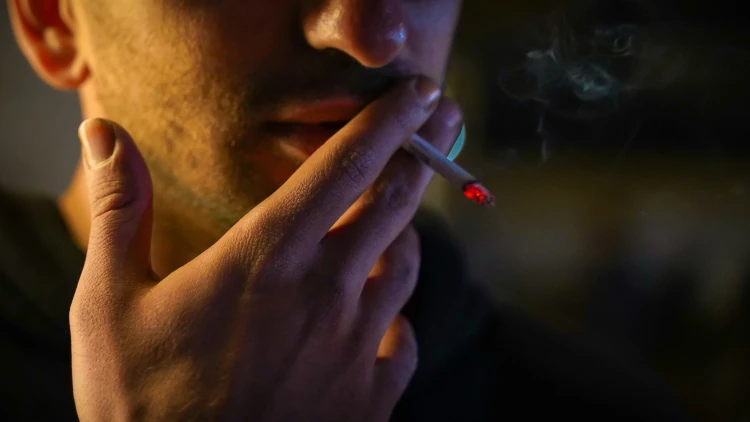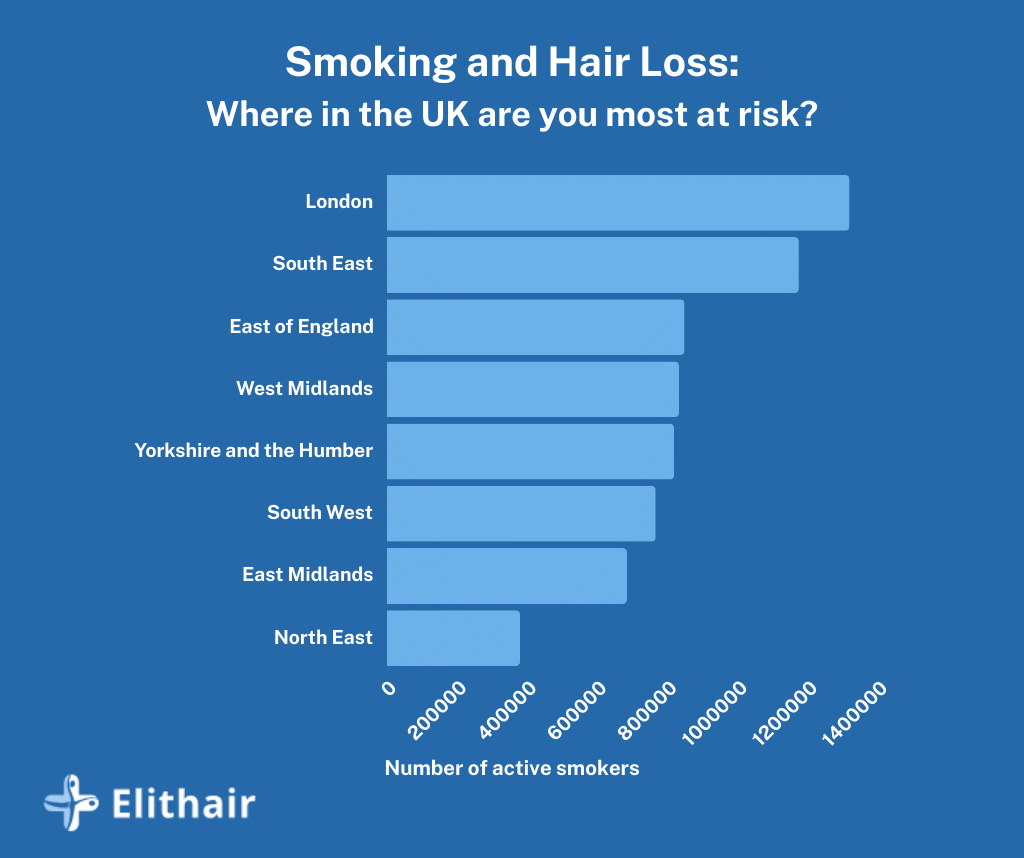
Smoking and Hair Loss:Where in the UK Is Most at Risk?
According to recent research, approximately 6.5 million men and 8 million women across the UK are impacted by hair loss; the most common cause being androgenetic alopecia (AGA). This genetic predisposition can be triggered by chemicals present in cigarettes. Androgenic alopecia, also known as male/female pattern baldness, has been found to impact 85% of men and 40% of women by the age of 50.
The Journal of Cosmetic Dermatology has released a study which has found that men, who are former or current smokers and smoke at least 10 cigarettes per day, are significantly more likely to develop androgenetic alopecia compared with those who have never smoked.
Summary
- How Does Smoking Impact Your Hair Health?
- What Areas in the UK Have the Largest Smoking Prevalence?
- Are Your Smoking Habits Causing Your Hair Loss?
- Signs Smoking Could Be Causing Androgenetic Alopecia
- Can You Have a Hair Transplant if You Smoke?
How Does Smoking Impact Your Hair Health?
Numerous studies indicate smoking has a detrimental effect on hair health due to two elements: reduced blood flow to the scalp and oxidative stress.
The chemicals present in tobacco can result in blood vessels in the scalp narrowing, which means that hair follicles are then deprived of the oxygen and nutrients needed for healthy growth – resulting in hair thinning and loss.
Alongside this, toxic chemicals found in cigarette smoke raise free radicals in the body, causing damage to cells and DNA, resulting in damaged hair follicles and prematurely ageing the scalp.
Given the link between smoking and androgenetic alopecia, areas in the UK with the highest smoking prevalence are potentially at a higher risk of widespread hair loss among their populations.
What Areas in the UK Have the Largest Smoking Prevalence?

According to Public Health Profiles data, London has the highest number of active smokers, per region in the UK, with 1,318,236 recorded from 2021 to 2022. London also recorded the lowest percentage of successful quitters year on year – with just a 0.8% decrease in the number of smokers compared to 2020/21. This equates to 1 in 7 people in London who actively smoke; a total of 15% of London’s overall population.
The South East ranks second in the list, with 1,173,783 smokers recorded from 2021 to 2022, revealing that approximately 14% of the overall community over the age of 15 smoke, making it another significant region where the prevalence of smoking could correlate with a higher risk of hair loss.
Following just behind is the East of England, which saw just a 1.6% decrease in smokers between 2021 and 2022, suggesting that a notable portion of the population is engaging in a lifestyle factor known to worsen hair loss issues.
Are Your Smoking Habits Causing Your Hair Loss?
Androgenetic alopecia can present initially as hair thinning, alongside a loss in a well-defined hair pattern, often characterised by the hairline receding to form an ‘M’ shape.
Smoking can exacerbate androgenetic alopecia by:
- A reduction of blood flow to the scalp: Blood flow to the scalp can see a significant reduction caused by the nicotine present in cigarettes. Constriction to the blood vessels means that your hair follicles are being deprived of vital oxygen and nutrients which, in turn, can impact your ability to maintain healthy hair.
- Chemicals in cigarettes that impact your hormones: The chemicals in cigarettes can impact the endocrine system, including the thyroid, adrenal and pituitary hormones. Both passive and active smoking are linked to decreased levels of TSH (thyroid-stimulating hormone), which can impact growth and development.
- A rise in free radicals: Harmful free radicals in the body can both disrupt hair growth cycles and damage hair follicles.
The areas in the UK with substantial numbers of smokers could therefore see a higher proportion of androgenetic alopecia among male residents, especially for those who are current or former heavy smokers.
Signs Smoking Could Be Causing Androgenetic Alopecia
If you are a heavy smoker, there are some signs to look out for which could signal the daily habit is impacting your hairline.
- Formation of a receding hairline
- Formation of a bald spot at the back of the head
- The final formation of a hair crown in the lower back of the head and temples
Hair loss caused by androgenic alopecia results from the gradual shrinking and thinning of hair follicles in susceptible areas. Eventually, these follicles cease to produce new hair and the existing hair falls out.
Can You Have a Hair Transplant if You Smoke?
While topical treatments, medications and laser therapy can all help with hair thinning and hair loss, a hair transplant is the only long-term (and most effective) method to combat androgenic alopecia successfully.
Those who smoke can undergo hair transplantation - it is recommended that you abstain from smoking for at least a week before the procedure.Following the surgery, smoking must be avoided for at least two weeks, as the same chemicals that initially impacted your hairline could have a detrimental effect on the outcome.
FAQ
What are the long-term effects of smoking on hair health?
Long-term smoking can lead to chronic scalp conditions, persistent hair thinning, and permanent hair follicle damage, making it difficult for hair to regrow even after quitting smoking.
Are there any specific vitamins or supplements that can counteract the effects of smoking on hair?
Vitamins like biotin, vitamin E, and antioxidants can help improve hair health by reducing oxidative stress and promoting healthier hair growth.
Can passive smoking also contribute to hair loss?
Yes, passive smoking exposes individuals to similar harmful chemicals found in cigarettes, which can also contribute to reduced blood flow to the scalp and increased hair loss.
What are some immediate steps smokers can take to improve hair health?
Quitting smoking, improving diet, using hair care products designed for damaged hair, and consulting a dermatologist for targeted treatments can help improve hair health.
How does smoking cessation impact hair regrowth?
Quitting smoking can improve blood circulation and nutrient delivery to hair follicles, potentially leading to healthier hair regrowth over time. However, results vary based on individual health and the extent of hair damage.


